
Best 3 Annuals for Windy Spots
By Chris Edmunds
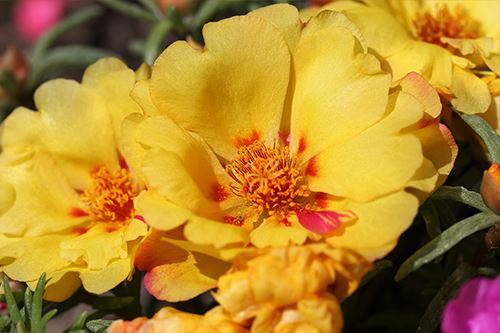
Prairie winds are a part of everyday life for us, and they can be really tough for gardeners. All it takes is one particularly gusty day to wreak havoc in the garden with toppled plants and broken stems - creating more work and harming the beauty and productivity of our gardens.
Luckily, there are a few plants out there that are resilient to some of our strong winds. Here are some of our favorite flowers that are strong enough to decorate your garden all summer long, no matter what kinds of blustery days we have in store.
Calibrachoa (aka Million Bells)
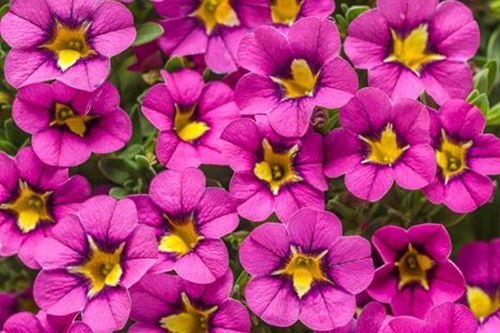 These flowers were named appropriately, and every summer we’re reminded of their superhero strength. With these sturdy blooms, you won’t have to worry about damage in the face of strong Kansas winds. But they aren’t all brawn. They also bring a stunning look and vibrant tones that make them the star of your patio container and hanging basket designs. Here are a few of our top picks for stunning garden color:
These flowers were named appropriately, and every summer we’re reminded of their superhero strength. With these sturdy blooms, you won’t have to worry about damage in the face of strong Kansas winds. But they aren’t all brawn. They also bring a stunning look and vibrant tones that make them the star of your patio container and hanging basket designs. Here are a few of our top picks for stunning garden color:
-
Superbells Coralberry Punch: Soft coral tones with a rosy red center
-
Superbells Pomegranate Punch: Vibrant scarlet red with a dramatic dark center, like a poppy
-
Superbells Grape Punch: Bright electric purple with a darker center
-
Superbells Dreamsicle: A cheerful and tropical blend of orange and coral blossoms
-
Superbells Tropical Sunrise: Stripes of fuchsia, yellow, and coral give these blooms stunning contrast that almost seems painted on
-
Superbells Hollywood Star: Bright fuchsia with a playful star-shaped yellow center
-
Superbells Evening Star: Soft lavender hues with vivid purple accents and a yellow star-shaped center
With so many beautiful varieties, it’s hard to pick just one - but we think these flowers look best when you bring home a few colors anyway! Try using complementary colors, like Evening Star and Grape Punch, or pairing bright colors like Dreamsicle and Tropical Sunrise. There are just so many fun combinations with these beauties, as Calibrachoa just might have more color options and variety of patterns in their blooms than any other species!
How to Grow Calibrachoa
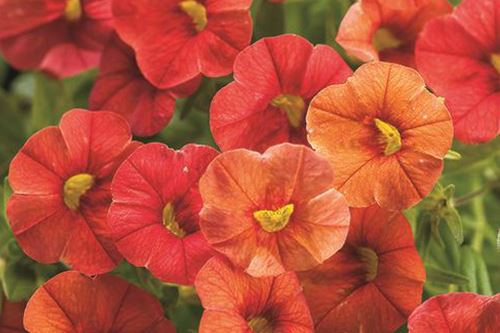 ‘Superbells’ need sunshine and fertilizer to fuel their blooming extravaganza, but their needs are fairly simple. Calibrachoa don't like wet feet. If you notice a plant is wilting even when the soil is damp, chances are, it's root rot. Water when soil on top feels dry to the touch.
‘Superbells’ need sunshine and fertilizer to fuel their blooming extravaganza, but their needs are fairly simple. Calibrachoa don't like wet feet. If you notice a plant is wilting even when the soil is damp, chances are, it's root rot. Water when soil on top feels dry to the touch.
They don’t require any deadheading, just fertilize them frequently (every two weeks) to give them the resources they need to bloom and keep blooming! If you live in an area that has been invaded by budworms (you would know if you’ve seen all the blooms on your petunias and calibrachoa get totally eaten away within a few days) watch for tiny holes in the blooms and spray your plants with Spinosad (a bacteria that kills worms without harmful chemicals) such as what’s in ‘Captain Jacks Deadbug Brew’ to stop these flower destroyers. You will have to treat a couple more times during the summer as new ones hatch or invade.
Calibrachoa don’t perform planted in the ground because of their sensitivity to the ph of soils in our area and their need for excellent drainage, but they are perfect for baskets and containers. Use a good quality potting soil and add a time-release fertilizer according to the label’s directions. (We recommend KVG GOOD STUFF potting soil and fertilizers because we formulated them specially for your area.) With a sunny location and a container with good drainage, your calibrachoa won’t need anything else to thrive all summer.
These plants are resilient where it counts, standing up to drought and high winds all summer. We've got a fabulous collection at our garden center in Woodlawn Wichita.
Purslane (Also called Portulaca)
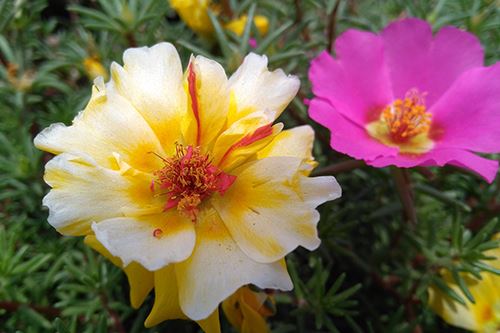 Purslane is very resilient when facing strong gusts of wind and drought, thanks to their thick, succulent-like leaves and stems. There are lots of choices for color with these blooms, but we always find ourselves drawn to the ColorBlast and Rio Grande varieties, thanks to their neon colors, like Watermelon Punch, Lemon Twist, and Rio Grande Yellow. Not shy to stand out, these flowers can be monochrome, striped, or even double-flowered proving just how much punch this plant can add to your seasonal look.
Purslane is very resilient when facing strong gusts of wind and drought, thanks to their thick, succulent-like leaves and stems. There are lots of choices for color with these blooms, but we always find ourselves drawn to the ColorBlast and Rio Grande varieties, thanks to their neon colors, like Watermelon Punch, Lemon Twist, and Rio Grande Yellow. Not shy to stand out, these flowers can be monochrome, striped, or even double-flowered proving just how much punch this plant can add to your seasonal look.
Our two favorite varieties this year, though, has to be the ColorBlast Double Scarlet and ColorBlast Double Magenta, thanks to their large double flowers that simply glow in the sun and command your attention from across your yard (and the attention of birds and butterflies). The new double-flowered purslanes have the added advantage, in that their blooms are so fully double, the petals don’t allow them to close like single flowered purslane do on cloudy days or at night so you can enjoy their super-bright colors all the time!
How to Grow Purslane
With a preference for full sun, purslane blooms offer a great choice for the spots in your yard that are hot and sunny, and they can handle wind easily. Although they can manage in almost any soil conditions, you’ll have the most attractive plants if you plant them in an area with good drainage, as staying too wet can cause root rot. Because they are so vigorous, fertilize every 2 to 3 weeks to keep them thriving and blooming all summer and into the fall.
Because they are so vigorous, it’s best to match them with other tough plants that can keep pace, or they are a joy to behold on their own, spilling over in big pots, hanging baskets or spreading over the ground in your flower beds!
Purple Fountain Grass
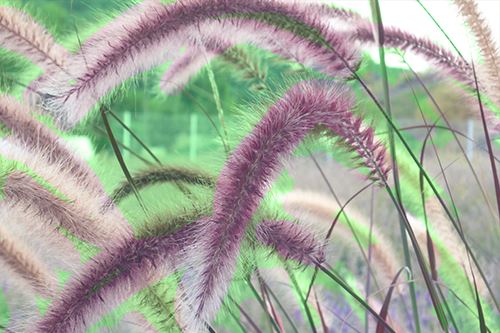 This ornamental grass is a fun way to add unexpected decoration to any garden, but we love the dramatic look it provides here in the prairies. Instead of fighting our winds, this plant embraces them and adds style to your backyard as it waves gently in the wind. Its fluffy, purple tufts are delightful fun, and they can grow to impressive heights, reaching 4- 5 feet tall given enough space, water, and fertilizer.
This ornamental grass is a fun way to add unexpected decoration to any garden, but we love the dramatic look it provides here in the prairies. Instead of fighting our winds, this plant embraces them and adds style to your backyard as it waves gently in the wind. Its fluffy, purple tufts are delightful fun, and they can grow to impressive heights, reaching 4- 5 feet tall given enough space, water, and fertilizer.
How to Grow Purple Fountain Grass
Whether you plant purple fountain grass in the garden, large containers, or landscape, give it lots of room to expand over the season. This grass is tough, so you won’t need to put very much work towards maintaining it over the summer. Water whenever the soil dries out and either mix a slow-release fertilizer into the soil before you plant or give it a dose of water soluble fertilizer a few times over the summer. Other than your usual weeding routine, that’s all this unique attention-grabber needs to stand out this summer. It’s purple foliage color is the perfect backdrop for so many other colors. Try planting with bright yellows and oranges such as Lantana “Luscious Marmalade” or “Little Lucky Pot of Gold” or with purples and lavenders like “Tidal Wave Silver” or “Supertunia Bordeaux”, and even hot roses like “Tidal Wave Cherry” or “SuperCal Neon Rose”.
Prairie winds don’t stand a chance against sturdy and tough plants like these, but we love when our garden can be both practical and gorgeous. Visit one of our stores today to check out these stellar choices and more this season!

